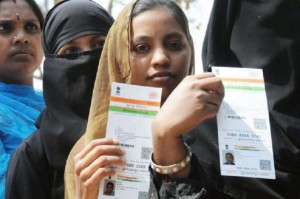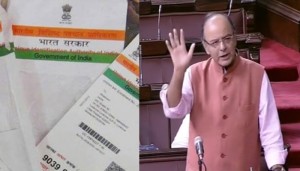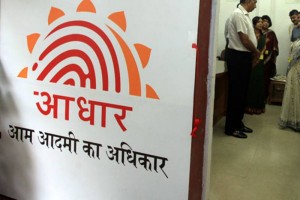This blog post written by Saanvi Singla, a student of University Institute of Legal Studies, Panjab University, highlights the implications of the Aadhaar Bill, 2016 on the life of a common man.
What Is an Aadhaar Card?
Aadhaar is a 12 digit individual identification number issued by the Unique Identification Authority of India (UIDAI) on behalf of the Government of India. This number serves as a proof of identity and address, anywhere in the country. Aadhaar letter received via Indian Post and e-Aadhaar downloaded from UIDAI website is equally valid.
 Any individual, irrespective of age and gender, who is a resident in India and satisfies the verification process laid down by the UIDAI, can enroll for Aadhaar. Every person needs to enroll only once, the enrollment procedure being free of cost.
Any individual, irrespective of age and gender, who is a resident in India and satisfies the verification process laid down by the UIDAI, can enroll for Aadhaar. Every person needs to enroll only once, the enrollment procedure being free of cost.
Each Aadhaar number will be unique to an individual and will remain valid for life. The Aadhaar number will help in providing services like banking, mobile phone connection and other Govt. and non-Govt. Services in due course.
Aadhaar is easily verifiable in an online, cost-effective way. It will be unique and robust enough to eliminate a large number of duplicate and fake identities in Govt. and private databases. In Aadhaar a random number is generated, devoid of any classification based on caste, creed, religion and geography. It establishes uniqueness of every individual by demographic and biometric information. It is a voluntary service that every resident can avail irrespective of present documentation[1].
Journey of Aadhaar
The Aadhar card fiasco completed a full circle on March 11, 2016, when the Aadhaar (Targeted Delivery of Financial and other Subsidies Benefits and Services) Bill. Since it was introduced as a Money Bill, the Upper House purists could not exercise their veto power, and the bill was passed in the Lower House with an overwhelming majority. Now it is for all practical purposes just short of becoming a law.
Before, the approval of the Lok Sabha its validity and legitimacy depended on a notification issued by the former Planning Commission. Due to this reason, the validity and legitimacy of Aadhaar were always under the scanner.
Critics have always rallied against the Aadhaar card scheme as the UIDAI is a body which is the archive of key personal information of the residents of the country and therefore risks breach of privacy. Due to this reason a petition[2] was filled by a former Karnataka High Court Judge, Justice K.S. Puttaswamy. Later a case was also registered under the same issue- UIDAI v. Central Bureau of Investigation(CBI)[3].
The issue of legitimacy and privacy always went hand-in-hand. But since the passing of the Bill, the Modi-led NDA government has been able to delink the two issues.
The Aadhaar has been considered as a unique concept in its way as technically it had a support of three regimes- the Atal Bihari Vajpayee-led NDA Government, the two termed UPA Government led by Dr. Manmohan Singh and now Narendra Modi-led NDA Government. In this sense, it is a rare piece of legislation on which there is political consensus among the two major national parties- the Bhartiya Janata Party (BJP) and the Congress.
The Aadhaar (Targeted Delivery of Financial and other Subsidies Benefits and Services) Bill, 2016
This bill was passed by the Lok Sabha with a staggering majority on March 16, 2016, and got the President’s consent on March 25, 2016. Due to this bill, the Aadhaar has attained its legitimacy. The salient features of the bill have been discussed below:
What was the bill about?
This bill proposes to provide targeted distribution of subsidies and services to individuals residing in the territory of India by assigning the Unique Identification Number authorized by the government called Aadhaar Cards. Aadhar cards are given to the residents of India and for a person to be a resident of this country he/she has to stay in the country for at least 182 days in a year.
What are the features of the bill?
For anyone to get the Aadhaar card number, the following details are to be submitted-
- Biometric (photograph, fingerprint, iris scan)
- Demographic (name, date of birth, address)
The number will be used to verify the identity of the person who is claiming a service or a subsidy. If a person does not have the Aadhaar number, he/she will have to apply for it. Otherwise, the said person will be given an alternative means of identification. Now any public or private entity can accept Aadhaar card as an identity proof for any purpose. But, the number will not be considered as a proof of citizenship or domicile.
What are the safeguards for the bill?
Only the UID Authority can authenticate the Aadhaar number of an individual if an entity makes a request for the same. The requesting entity has to obtain the consent of the particular person before collecting the respective information. The agency is allowed to use the information only for the purpose for which the respective person has given his/her consent.
The authority is not allowed to share biometric information and other biological attributes. This information will only be used for the enrollment and authentication.
What are the exceptions for the sharing of information?
As per the Section 33 of the Bill, private information can be revealed in two cases-
In the interest of “national security”, a joint secretary in the central government may issue a direction for revealing –
- Aadhaar no.
- Biometric information
- Demographic information
- Photograph
Such a decision will be reviewed by an oversight committee (comprising of Cabinet Secretary, Secretaries of Legal Affairs and Electronics and Information Technology) and will be valid for six months.
On the order of a court –
- An individual’s Aadhaar No.
- Photograph
- Demographic information can be revealed.
What are the offenses and punishments for violation?
A person shall be penalized with imprisonment up to three years and a minimum fine of ten lakhs for unauthorized access to the centralized database, including revealing any information stored in it. If a requesting entity and an engaging agency fail to comply with rules, they shall be punished with imprisonment up to one year or a fine up to Rs. 10,000 to Rs. 1 lakh (in case of a company) or both[4].
Arguments and Counter-Arguments
Many objections have been raised by the opposition about the approval of the Aadhaar Bill, 2016. The opposition has accused the government of playing a dirty game of politics by introducing the bill as a money bill as the Upper House has no say in the approval of a money bill. The second objection raised by the opposition was about the Right to Privacy. They had pleaded that since the said matter is being tried in the Supreme Court and legislation should not be passed on the said issue. The opposition in the Upper House has also objected to the use of the words “national security” saying that the term has been misused.
The government has given answers to all these objections. According to Arun Jaitley, Aadhaar Bill is a money Bill as it deals with the subsidies for which money flows out of the Consolidated Fund of India. The second argument was countered by Mr. Jaitley, who pointed out the provision of “Separation of Power” in our Constitution. The third argument was countered on the basis that the terms suggested in the place of “national security” were vague and ambiguous in nature and thus could not be used. He said that the term “national security” has evolved with time and is properly defined and due to this reason it has been used in the bill.
After all these arguments and counter arguments, the bill was passed with a huge majority in the Lower House and received the assent of the President. On March 26, 2016, theGazette of India issued a notification on the Aadhaar Bill.
But on April 7, 2016, Mr. Jairam Ramesh, member of Rajya Sabha, moved a petition[5] in the Supreme Court challenging and passing the said bill. On April 25, 2016, the Supreme Court wished to hear the matter and moved the petition made by Mr. Jairam Ramesh. On May 10, 2016, the Attorney General of India argued that the power of the Speaker of Lok Sabha to declare a bill as a Money Bill is not open to judicial review. Still, the Supreme Court asked Mr. Jairam Ramesh to submit a note of his submission and case laws and adjourned the case till July 2016[6].
Conclusion
The passing of this bill has been a very rigorous process. This bill has gained a lot of media coverage and importance in the past few months. Now, that this bill has been finally approved, the clouds of doubt have still not left it. The petition filed by Mr. Jairam Ramesh will play a deciding factor in this bill being converted into law.
Nevertheless, the passing of this bill is a big thing as it is a very important part of the ambitious financial inclusion program of the Narendra Modi government.
Now, Aadhaar can be used in official dealings. It will play a key role in the JAM-Jan Dhan, Aadhaar, and Mobile which will be driving force of the ambitious plan of technology-enabled, real-time direct benefits transfer system.
During the first stage of the project, JAM effectively dealt with the transfer of subsidies in the account of the customer due to which leakages have dropped drastically. But, to take this project to the next level legitimization of Aadhaar was necessary.
A major key to this project is the payment banks. 19 of which were awarded licenses by the Reserve Bank of India (RBI) last year which includes companies like Airtel M Commerce Services Ltd., part of Bharti Airtel which have a customer base of nearly 240 million and about 150,000 post offices among which 140,000 are in the rural area[7].
To them, Aadhaar will act as an e-identity to keep the transaction cost low and therefore provide a business model for financial inclusion.
In this way, Aadhar is going to play a crucial role in the life of the common man of this country.
[divider]
Footnotes:
[1]https://uidai.gov.in/what-is-aadhaar.html
[2] W.P.(C) 494/2012
[3] SLP (Crl) 2524/2014
[4] http://www.firstpost.com/politics/aadhaar-number-is-not-proof-of-indian-citizenship-all-you-need-to-know-about-the-bill-2678496.html
[5] W.P. (C) 231/2016
[6] http://www.legallyindia.com/blogs/journey-of-aadhaar
[7] http://www.livemint.com/Opinion/Kp0eY8BDHpbgXghQyHerrJ/Everythings-official-about-Aadhaar-now.html
 Serato DJ Crack 2025Serato DJ PRO Crack
Serato DJ Crack 2025Serato DJ PRO Crack










 Allow notifications
Allow notifications


